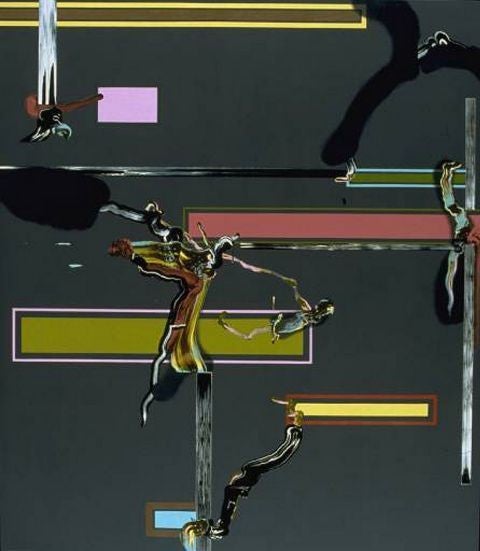Thomas Sutcliffe: Sounds to enthral the eyes

Your support helps us to tell the story
From reproductive rights to climate change to Big Tech, The Independent is on the ground when the story is developing. Whether it's investigating the financials of Elon Musk's pro-Trump PAC or producing our latest documentary, 'The A Word', which shines a light on the American women fighting for reproductive rights, we know how important it is to parse out the facts from the messaging.
At such a critical moment in US history, we need reporters on the ground. Your donation allows us to keep sending journalists to speak to both sides of the story.
The Independent is trusted by Americans across the entire political spectrum. And unlike many other quality news outlets, we choose not to lock Americans out of our reporting and analysis with paywalls. We believe quality journalism should be available to everyone, paid for by those who can afford it.
Your support makes all the difference.I've been listening to art recently – not aural sculptures or concrete poetry, but the kind you hang on walls. Walking round Kenwood House in north London with the dog the other day, for example, I listened to Fiona Rae's 1998 painting Night Vision, a large abstraction that plays off areas of flat colour against gestural splashes of colour. Coming back from the newsagent, I listened to François-Hubert Drouais' Madame de Pompadour at her Tambour Frame from the National Gallery's collection.
A little later, I listened to some Georg Baselitz paintings from the Royal Academy's recent retrospective (several of which, naturally, I had to listen to upside down). All of these were made available by that most modish of additions to the big gallery's outreach and education programmes – the podcast, downloaded to my iPod (although other devices are available) and listened to at leisure.
I can't remember which of them I stumbled over first. I think I was just browsing through the iTunes Store podcasts section and noticed that there was a section devoted to Arts, an odd miscellany that encompasses amateur photography tutorials, The Archers, publishers' advertorials and Harry Potter podcasts, but which includes material from the Tate, the Royal Academy and the National Gallery. The Tate is positively mad for the enterprise, offering no less than six separate podcasts, including a series called TateShots, which offers short videos about contemporary works in the gallery, and the Modern Paints podcast, which takes you on a "tour around the paint surfaces of 10 key works on display at Tate Modern".
TateShots' title hints at the desired effect of these things – a pub double-measure of contemporary art, taken neat and intended to whet the appetite for a more direct engagement with the works in the collection. That is, I take it, the intention of all gallery podcasts: not that they should save you the trouble of a visit and do their bit for carbon-emissions reduction, but that they should galvanise you into coming in. Some of them, in fact, are pretty straightforwardly promotional, tricking out a list of forthcoming events and exhibitions with mini-features, styled after a conventional arts magazine programme.
Others come at the thing more obliquely, as if anxious not to startle the un-enlisted. One of the Tate's offerings – "What Can the Matter Be?" – hovers on the brink of unintentional comedy, inviting a team from the Materials Library to explore works from a sensory point of view. My favourite is the scene in which a bemused gallery-goer is invited to contemplate a Francis Bacon triptych while manipulating a wodge of pink silly putty, apparently a catalyst for fresh thoughts about Bacon's fleshy biomorphs.
And you aren't, of course, listening to the art at all, but to the people who mill about it: artists, curators, conservators and critics. What's interesting, though, having listened to several of the recent podcasts, is the sharp distinction between what works and what doesn't. To put it at its crudest, facts get through while opinion tends to fade to grey almost immediately. This isn't entirely fair to opinion, by the way. After all, since these are in-house productions, you're not likely to get it at its most piquantly flavoursome, despite the fact that opinion can be a tantalising sauce. I would imagine, for example, that hearing Brian Sewell roundly excoriate a new exhibition would be just as likely to provoke a visit as hearing a hired voice tell you about its "transcendent" qualities. But even allowing for that distortion, it's clear that nothing can touch simple information as a form of seduction.
Take the Fiona Rae podcast, in which the artist herself explains how she painted one of her pictures. It is as plain a piece of broadcasting (or narrowcasting, if you want to be pedantic) as you could imagine; she talks about which bits are painted in acrylic and which bits are painted in oils, why she used different paint for different sections, and how she goes about putting the composition together. Apart from the odd technical term, I don't think that there's a word employed that a six-year-old wouldn't understand, and it is refreshingly free of catalogue jargon, such as "facticity" and so on. At the same time, it contains information that would, I imagine, genuinely liberate your inspection of the thing itself. She explains, for example, that she turns the canvas around as she paints. There is no "top" or "bottom" until it's on the wall – a detail that at least loosens the reflexive urge to read abstracts as subject to gravity, even if it can't detach it altogether. And having heard the painting speak in its own voice, I'm genuinely curious to see it next time I'm in. Podcasts may be modish but, done properly, they work.
Join our commenting forum
Join thought-provoking conversations, follow other Independent readers and see their replies
Comments